#purification spring
Explore tagged Tumblr posts
Text

Spring of Purification~
#pokemon rejuvenation#aelita#spring of purification#cherry blossoms#fireflies#i love her sm#she's the reason i physically cannot force myself to play renegade#im too weak#alexa please do not play cassandra by taylor swift#listening to axiom waltz (both versions) while making this was psychically devastating#anyway happy spring lol!
139 notes
·
View notes
Text
*Killer and Dust are texting*
Dust: Please bring home PURIFIED water with NO minerals added for taste. NONE.
Killer: I got spring water.
Dust: NO!
Killer: With EXTRA minerals!
Killer: It's like licking a stalagmite!
Dust: DON'T COME HOME!
Killer: Mmmmmm, cave water.
#incorrect quotes#undertale au incorrect quotes#undertale incorrect quotes#killer sans#killertale#killertale sans#dusttale sans#dusttale#dust sans#i actually prefer spring water to purifed water#incorrect quote generator
25 notes
·
View notes
Text
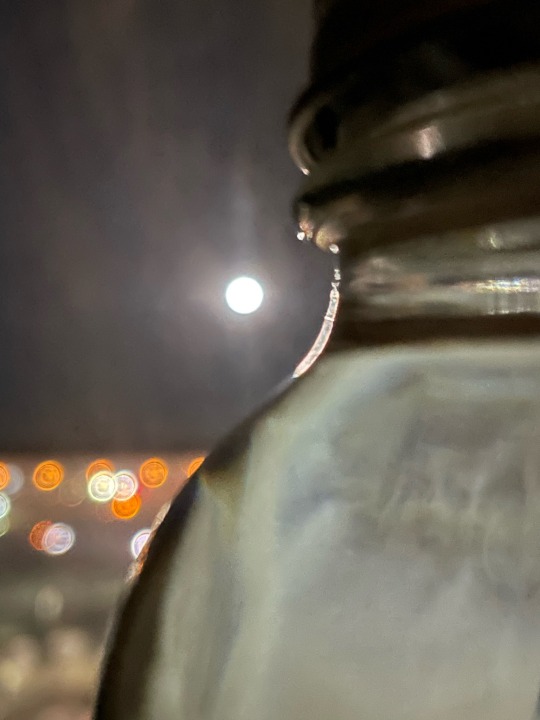
Charging the water under the pink moon.
#full moon#moonwater#pink moon#april 2024#purification#power#nature#moon#witchy#witchcraft#once upon a witchlight#kitchen witch#witch community#green witch#witches#baby witch#witch aesthetic#witchblr#spring#night#positive vibes#city witch
8 notes
·
View notes
Photo

On February the 1st we celebrate the Second Sabbath of the Wheel of the Year, the midpoint between the winter solstice and the spring equinox, the first spring festival, the harbinger of spring.
We celebrate the purification of the sacred child and the transformation of the mother, the rebirth of the maiden.
We celebrate the snowdrop, the first flower that signs the rebirth of nature.
We celebrate the birth of the lambs, the sacred milk that feed us all and the great mother that nurture us and help us grow in this winter season.
We feast and honor the gods and the spirits of nature; we purify and clean our house and garden to get ready for the coming of spring and the coming of this new life.
#witchcraft#witchblr#Strega#pagan witch#imbloc#Wheel of the Year#italian witch#italianwitch#witches of tumblr#paganism#springiscoming#purification#renewal#great mother#great godess#horned god#snowdrop#cleansing#witches sabbath#spring
30 notes
·
View notes
Text
2nd February
Candlemas

The Presentation in the Temple by Luis de Morales (1562). Source: Public Domain/ National Catholic Register website
Today is Candlemas. Its origins lie in the Roman feast that celebrates the goddess Februa, who gave her name to the whole month. Candles were lit and torchlit processions took place as part of the festivities. The early Christians adopted the tradition (along with the candle lighting associated with Bride the previous day) and renamed the day the Purification of Mary, 40 days after the birth of Jesus and marked the presentation of the infant at the Temple in Jerusalem. Much candle lighting also accompanies the Christian ceremonies.
Candlemas became one of the Welsh Quarter Days and an occasion for rural trading fairs. ‘Silver’ John Lloyd was a staple at the fair at Radnor Forest in Powys, where, in the nineteenth century, he would set bones in return for payment in silver buttons which he sewed into his coat. One day Silver John went missing and it was not until the following Candlemas Fair that he was discovered by a skater, frozen in the ice covering a nearby lake. He could not be freed from his icy prison until the thaw and an unhappy John continues to haunt the area around Llyn Hilyn. His silver laden coat was missing so foul play was assumed which probably explains his restless spirit. No one was ever charged with his murder, but a local folk song about Silver John’s demise blamed ‘the Radnor Boys’ for his killing.
Today is also held traditionally to be the beginning of spring, which sounds curious to us nowadays, as we consider we have at least another six weeks of the cold dark season to go.
#candlemas#purification of Mary#presentation at the temple#silver John Lloyd#Radnor#spring#The Radnor Boys#februa#quarter day
1 note
·
View note
Text
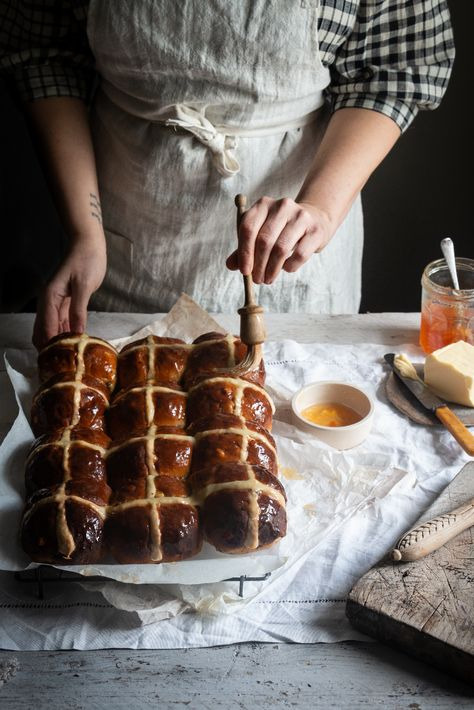
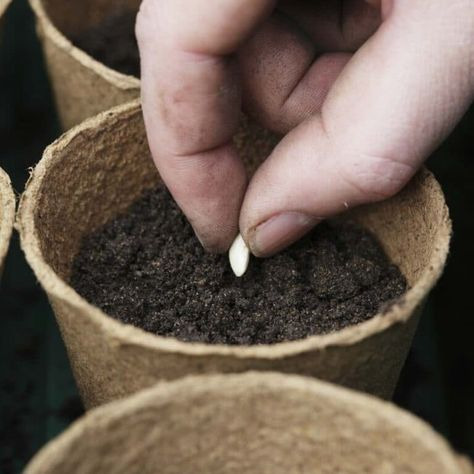


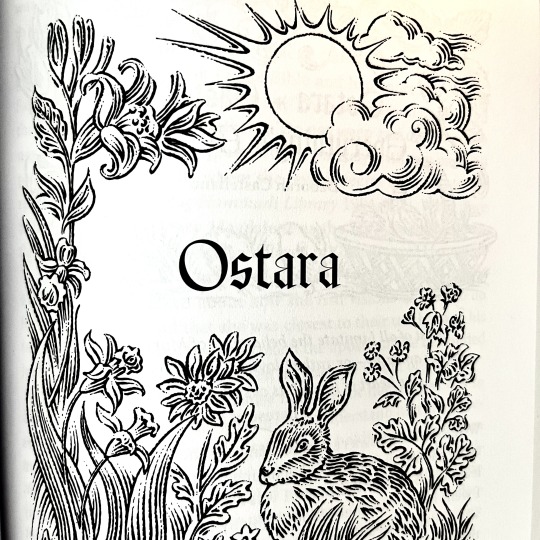

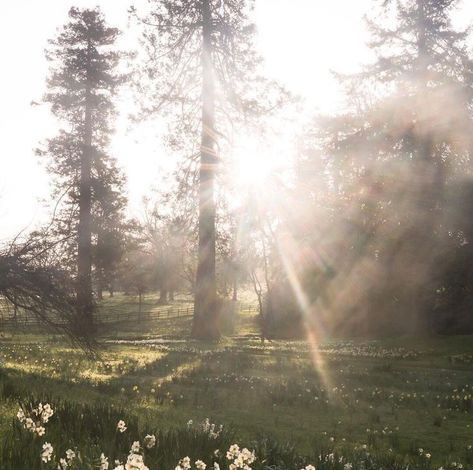

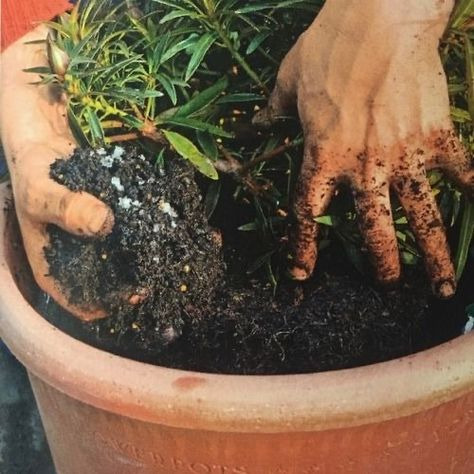
Ostara (March 19-21)
Ostara is this week, with this sabbat we celebrate the beginning of spring and perfect balance between night and day. The winter months are officially over, and from now on everything will bloom and get warmer 🌞
Correspondences for Ostara: Symbols | Eggs, seeds, flowers, hare Colors | Pastel colors, green, yellow, pink, white Spells | Fertility, growth, balance, purification and abundance Crystals | Amethyst, clear quartz, lapis lazuli, rose quartz, jasper Herbs and flowers | Lavender, tulips, rose, daffodils, lily’s Foods | Eggs, breads (hot cross buns), cake, chocolate, seeds, fruits How to celebrate | Baking, dying or painting eggs, planting seeds (woth intention), nature walks, spring cleaning.
#witchy#witchy things#witchyvibes#witches#witch#whimsigoth#whimsigothic#witchythings#whimsical#witchcraft#witch aesthetic#witch blog#witch community#witch post#witch stuff#witchcore#witchcraft community#witches of tumblr#witchlife#witchy stuff#magick#pagan#ostara#spring#spring equinox#wheel of the year#witchy woman#paganism
2K notes
·
View notes
Text
Spring Equinox Masterpost- Spoonie Witch Friendly
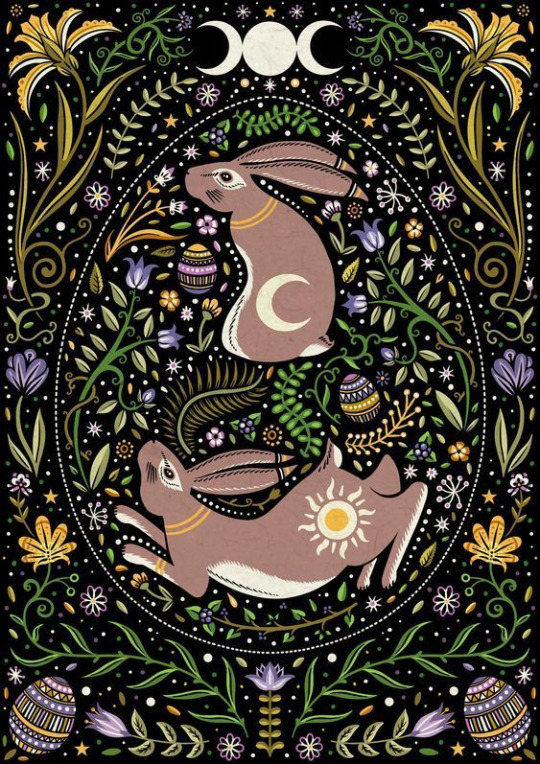
Art Credit: Anastasia Catris
The Spring Equinox, also called the Vernal Equinox or Ostara, is usually celebrated between the 21st of March in the Northern Hemisphere (In the Southern Hemisphere around September 20th or 21st)
In 2024, Ostara and the Spring Equinox land in the Northern Hemisphere on Monday, March 19th.
The Spring Equinox celebrates the arrival of spring. Celebrating balance, growth, and new beginnings as Winter has finally ended.
Spring Equinox Correspondances
Colours
Light Green
Lavender
Sunny Yellow
Light Blue
Pastel Pink
White
Herbal
Lemongrass
Daffodils
Tulips
Violets
Apple Tree
Cherry Blossom
Primrose
Birch tree
Hyacinths
Dandelion
Garlic
Ash tree
Jasmine
Edibles
Honey
Salad greens
Spring veggies
Fresh berries
Mead
Herbs
Eggs
Seeds
Bread
Edible flowers
Quiches
Custards
Maple
Animals
Hares
Baby Chicks
Snakes
Robins
Bees
Butterflies
Phoenix
Ram
Crystals
Fluorite
Moonstone
Silver
Aquamarine
Clear Quartz
Amazonite
Symbols
Bonfires
Flowers
Rabbits
Eggs
Seeds
Baskets
Flowering or Tree Buds
Lambs
Birds
Spiritual meanings
Purification
Cleansing (removal of stagnant energy)
Growth
Transition
Motivation
Balance
Birth
Good fortune
Kindness
Joy
Fertility
Scents
Coconut
Citrus
Floral scents (rose, lilac, jasmine, etc)
Herbal scents (rosemary, basil, mint, etc)
Gods / Goddesses / Spirits
Eostre – (Anglo-Saxon)
Aphrodite - (Greek)
Gaia - (Celtic)
Gaea - (Greek)
Venus - (Roman)
Athena - (Greek)
Aurora - (Roman)
Eos - (Greek)
Isis – (Egyptian)
Freya - (Norse)
Persephone - (greek)
Cybele - (Roman)
The Green Man - (Celtic)
Odin – (Norse)
Osiris – (Egyptian)
Pan – (Greek)
Thoth – (Egyptian)
Adonis – (Greek)
Apollon – (Greek)
Apollo - (Roman)
Need some suggestions to celebrate? I've got you covered.
High energy celebrations and ritual
Deep cleaning of the hearth and home
Nature hikes
Visiting farmers markets
Making preserves
Create a fae garden
Create a seasonal altar
Abundance/Prosperity ritual
New beginnings ritual
Low energy celebrations
Wear pastels
Create flower crowns
Light a candle with scent correspondence
No spoon celebrations
Opening a window
Journaling Prompts
Keeping hydrated
Drink floral tea
Rest
How you celebrate the holiday does not matter. You can choose to do any activity that feels right. These are only suggestions and remember that you're enough no matter what.
Also please note some stuff is UPG. A great book is Year of the Witch by Temperance Alden for honouring the celebrations and if you wanted to work more seasonally. It's not Wiccan-based and has plenty of resources for every witch.
Feel free to post how you celebrate in the comments or reblogs!
Want to see more of my posts? Check out my Wheel of the Year Masterpost or my Main Masterpost.
#witchcraft#witch#electic witch#witchblr#paganism#spoonie witch#spoonie magic#ostara#wheel of the year#witchy#spring equinox#seasonal magic#ostara masterpost#ostara correspondences#spring equinox masterpost#spring equinox correspondances#spoonie#chronic illness magic#chronic illness
1K notes
·
View notes
Text
Thank you so much, this sounds excellent and the cleansing spiritual baths post is super helpful as well! I really appreciate all the options you've listed - not to mention the fact that so many of them are so easy to get hold of 🙏
🌿 herb asks open 🌿
I am in a custom herb blends groove atm after not doing much of that for a while, it's kind of nice
shoot me an ask or reply to this post if you'd like suggestions for a smoking, tea, incense, or magic(k)al (jar/pouch/floor wash/etc) herbal blend and I'll make you some suggestions
ailments, nice vibes, devotional, whatever
add your vague location and I may be able to include stuff that's available wild in your area! tho I can't promise that. but I'll give it some thought 🤔
#had an uncomfortable realisation the other day and i've done some basic things to mitigate#but we need some spring (well. fall.) cleaning around here#resources#magic#herbalism#purification#as someone who knows a lot about plants i'm sooooo bad at using them magically. need to get on that.
55 notes
·
View notes
Text
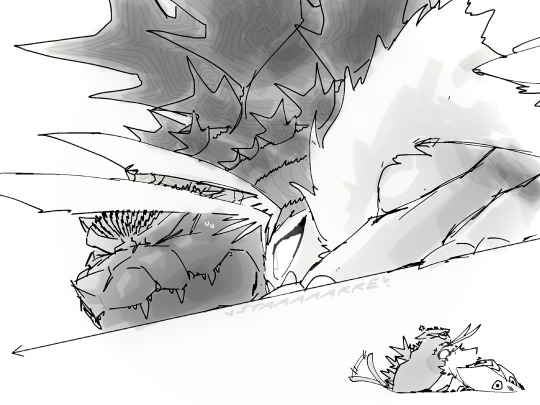

I’ve talked before about my ideas on where a new film run following G: Minus One could go, but I’ll expand a little on it.
So, the first film is done, Godzilla’s in pieces at the bottom of the ocean, and Noriko got hit with some of that goji-goop. My idea is that, over time, all of those chunks of the original Godzilla will regrow into some new abominations; some with horns and broad wings, some with crowns and thick, armoured hides, and all with vague memories of pain and destruction that somehow feel like they are and aren’t theirs, driving them into conflict with humanity. One chunk, of course, becomes Godzilla’s second raid, the memories much more vivid in his head but still, an individual seperate from the original.
Now, while it’d be cool for Mothra to also be one of those regrown chunks, only with a lot more purity and nobility and whatnot, she could potentially tie in well with the whole “goji-goop” thing going on. For instance, if Noriko unfortunately passes and is left a rose where her body lies in the soil, that could lead into Biollante, a late human spirit, a maternal human spirit, reanimated and twisted by the Godzilla‘s mutation and his lingering obsession. Now, once Biollante meets her demise and Noriko gets her final “goodbye”, what springs from this spiritual purification is an egg, and from that egg sprouts the eternal, maternal, noble and pure Mothra.
From here, Mothra can be undyingly defensive of humanity and would fight anyone for their sake, but maybe, can also be fascinated by Goji to the point of following him around and observing him up close, much to his dismay and for no other reason other than I’m a hopeless mothzilla shipper.
Otherwise, I’ll leave it for anyone else to make something of my thoughts.
#godzilla#gojira#mothra#mosura#kaiju#toho kaiju#fanart#mothzilla#Toho#toho godzilla#godzilla minus one#godzilla minus 1#sequel spec#I love having Mothra just staring admirably at Goji with those high-beams#guys help I’m trying to be the god of destruction#but the physical embodiment of mother nature has a HUGE crush on me#she literally won’t leave me alone
169 notes
·
View notes
Text
May 2024 witch guide
Full moon: May 23rd
New moon: May 7th
Sabbats: Beltane-May1st
May Flower Moon
Known as: Bright Moon, Budding Moon, Dyad Moon, Egg Laying Moon, Frog Moon, Hare Moon, Leaf Budding Moon, Merry Moon, Moon of the Shedding Ponies, Planting Moon, Sproutkale, Thrimilcmonath & Winnemanoth
Element: Fire
Zodiac: Taurus & Gemini
Nature spirits: Elves & Faeries
Deities: Aphrodite, Artemis, Bast, Cernunnos, Diana, Frigga, Flora, Horned God, Kali, Maia, Pan, Priapus & Venus
Animals: Cat, leopard & lynx
Birds: Dove, Swallow & Swan
Trees: Hawthorne & rowan
Herbs: Cinnamon, dittany of Crete, Elder, mint, mugwort & thyme
Flowers: Foxglove, lily of the valley & rose
Scents: Rose & sandalwood
Stones: Amber, Apache tear, carnelian, emerald, garnet, malachite, rose quartz, ruby, tourmaline & tsavorite
Colors: Brown, green, orange, pink & yellow
Energy: Abundance, creative energy, faerie & spirit contact, fertility, intuition, love, marriage, material gains, money, propagation, prosperity, real-estate dealings, relationships & tenacity
May’s Flower Moon name should be no surprise; flowers spring forth across North America in abundance this month!
• “Flower Moon” has been attributed to Algonquin peoples, as confirmed by Christina Ruddy of The Algonquin Way Cultural Centre in Pikwakanagan, Ontario.
May’s Moon was also referred to as the “Month of Flowers” by Jonathan Carver in his 1798 publication, Travels Through the Interior Parts of North America: 1766, 1767, 1768 (pp. 250-252), as a likely Dakota name. Carver stayed with the Naudowessie (Dakota) over a period of time; his expedition covered the Great Lakes region, including the Wisconsin and Minnesota areas.
Beltane
Known as: Beltaine, May day, Roodmas & Cethsamhain
Season: Spring
Symbols: Eggs, faeries, fire, flowers & maypoles
Colors: Blue, dark yellow, green, light pink, orange, red, white yellow & rainbow spectrum
Oils/Incense: Frankincense, lilac, passion flower, rose, tuberose & vanilla
Animals: Bee, cattle, goat & rabbit
Mythical: Faeries
Stones: Bloodstone, emerald, lapis lazuli, orange carnelian, rose quartz & sapphire
Food: Beltane cakes, cherries, dairy foods, farls, green herbal salads, honey, meade, nuts, oat cakes, oats, strawberries & sweets
Herbs/Plants: Almond, ash tree, birch, bramble, cinquefoil, damiana, frankincense, hawthorn, ivy, meadowsweet, mushroom, rosemary, saffron, satyrion root, St.John's wort & woodruff
Flowers: Angelica, bluebell, daisy, hibiscus, honeysuckle, lilac, marigold, primrose, rose, rose hips & yellow cowslips
Trees: Ash, cedar, elder, fir, hawthorn, juniper, linden, mesquite, oak, pine, poplar, rowan & willow
Goddesses: Aphrodite, Areil, Artemis, Cybele, Danu, Diana, Dôn, Eiru, Elen, Eostre, Fand, Flidais, Flora, Freya, Frigga, Maia, Niwalen, Rhea, Rhiannon, Var, Venus & Xochiquetzal
Gods: Baal, Bacchnalia, Balder, Belanos, Belenus, Beli, Beltene, Cernunnos, Cupid, Faunus, Freyr, Grannus, The Green Man, Lares, Lugh, Manawyddan, Odin, Pan, Puck & Taranis
Issues, Intentions & Powers: Agriculture, creativity, fertility, lust, marriage, the otherworld/Underworld, pleasure, psychic ability, purification, sensuality, sex/uality, visions, warmth & youth
Spellwork: Birth, Earth magick, healing, health & pregnancy
Activities:
• Create a daisy chain or floral decorations
• Decorate & dance around a Maypole
• Set up an outdoor altar & leave offerings to faeries
• Prepare a ritual bath with fresh flowers
• Light a bonfire or candles & dance around them
• Set aside time for self care
• Gather flowers & use them to decorate your home or altar
• Prepare a feast to celebrate with friends/family
• Make flower crowns
• Bake bannocks, oat cakes or cookies
• Hang wreaths decorated with ribbons & flowers
• Plant flowers in your garden
• Start a wish book/box/journal
• Go on a walk & gice thanks to nature⁸
• Cast fertility or a bunch spells
• Fill small baskets of flowers & small goodies, then leave them on your friends/neighbors doorstep as a gesture of goodwill & friendship
Beltane is mentioned in the earliest Irish literature and is associated with important events in Irish mythology. Also known as Cétshamhain ('first of summer'), it marked the beginning of summer & was when cattle were driven out to the summer pastures. Rituals were performed to protect cattle, people & crops, and to encourage growth. (Today, Witches who observe the Wheel of the Year celebrate Beltane as the height of Spring.)
Special bonfires were kindled, whose flames, smoke & ashes were deemed to have protective powers. The people and their cattle would walk around or between bonfires & sometimes leap over the flames or embers. All household fires would be doused & then re-lit from the Beltane bonfire.
These gatherings would be accompanied by a feast, and some of the food and drink would be offered to the aos sí. Doors, windows, byres and livestock would be decorated with yellow May flowers, perhaps because they evoked fire.
In parts of Ireland, people would make a May Bush: typically a thorn bush or branch decorated with flowers, ribbons, bright shells & rushlights. Holy wells were also visited, while Beltane dew was thought to bring beauty & maintain youthfulness.
• The aos sí (often referred to as spirits or fairies) were thought to be especially active at Beltane. Like Samhain, which lies directly opposite from Beltane on the Wheel of the Year, this was seen as a time when the veil between worlds was at its thinnest. At Samhain the veil between the worlds of the living & the dead is thin enough that we can connect & convene with our beloved dead, here at Beltane it’s the veil between the human world, and the world of faeries & nature spirits that has grown thin. Offerings would be left at the ancient faerie forts, the wells and in other sacred places in an effort to appease these nature spirits to ensure a successful growing season.
Some believe this is when The Goddess is now the Mother & the God is seen as the Green Man or the wild stag. It celebrates the symbolic union, mating or marriage of the Goddess & God & heralds in the coming summer months. It represents life rather than Samhain on the opposite side of the Wheel of the Year.
Other Celebrations:
• Rosealia- May 23rd
Rosalia or Rosaria was a festival of roses celebrated on various dates, primarily in May, but scattered through mid-July. The observance is sometimes called a rosatio ("rose-adornment") or the dies rosationis, "day of rose-adornment," & could be celebrated also with violets. As a commemoration of the dead, the rosatio developed from the custom of placing flowers at burial sites. It was among the extensive private religious practices by means of which the Romans cared for their dead, reflecting the value placed on tradition (mos maiorum, "the way of the ancestors"), family lineage & memorials ranging from simple inscriptions to grand public works. Several dates on the Roman calendar were set aside as public holidays or memorial days devoted to the dead.
Roses had funerary significance in Greece, but were particularly associated with death & entombment among the Romans. In Greece, roses appear on funerary steles & in epitaphs most often of girls. Flowers were traditional symbols of rejuvenation, rebirth &memory, with the red & purple of roses & violets felt to evoke the color of blood as a form of propitiation
Sources:
Farmersalmanac .com
Llewellyn's Complete Book of Correspondences by Sandra Kines
Wikipedia
A Witch's Book of Correspondences by Viktorija Briggs
Encyclopedia britannica
Llewellyn 2024 magical almanac Practical magic for everyday living
#witch guide#may 2024#flower moon#sabbat#wheel of the year#beltane#beltaine#witchblr#wiccablr#paganblr#witch community#witchcore#witchcraft#witches of tumblr#tumblr witch community#tumblr witches#moon magic#spellbook#grimoire#book of shadows#witch#traditional witchcraft#spellwork#beginner witch#baby witch#witch tips#witch tumblr#baby witch tips#GreenWitchcrafts#witch friends
429 notes
·
View notes
Text
Imbolc Altar Ideas & Correspondences

Imbolc, also known as Candlemas or Brigid's Day, marks the halfway point between the winter solstice and the spring equinox. It's a time to celebrate the returning light and the awakening of the Earth.
Altar Decorations:
Candles: Imbolc is strongly associated with the element of fire. Decorate your altar with candles in shades of white, yellow, and light blue to represent the increasing daylight.
Brigid's Cross: Craft or purchase a Brigid's Cross, a traditional symbol associated with the Celtic goddess Brigid. Hang it on your altar as a protective charm.
Seasonal Flowers: Place early spring flowers like snowdrops, crocuses, and daffodils on your altar. These symbolize the first signs of life returning to the land.
Herbs: Incorporate herbs such as rosemary, thyme, and cinnamon for their purifying and invigorating properties. Bundle them together with a red or white ribbon.
Seeds: Represent the potential for growth by adding a dish of seeds to your altar. Consider seeds associated with early spring crops like wheat or herbs.
Imbolc Symbols: Include symbols like lambs, ewes, and the sun to capture the essence of this seasonal transition.
Candle Holders: Choose unique candle holders or lanterns to enhance the ambiance. Consider using candle holders in the shape of suns, stars, or nature-inspired designs.
Divination Tools: Add divination tools like tarot cards or runes to your altar for seeking guidance during this transitional period.
Symbolic Stones: Integrate crystals such as citrine for abundance, aquamarine for clarity, and moonstone for intuition. Arrange them aesthetically around your altar.
Feathers: Symbolizing air and spirituality, feathers can be incorporated to invoke the energy of the season. Choose feathers from birds associated with the goddess Brigid, like swans or owls.
Artwork: Display artwork or illustrations that resonate with the themes of Imbolc. This could include depictions of Brigid, snow-covered landscapes, or symbols of growth and renewal.
Imbolc Incense: Craft or purchase incense blends with scents like frankincense, myrrh, and chamomile to fill your sacred space with a soothing and purifying aroma.
Correspondences
Goddess Brigid: Imbolc is sacred to Brigid, the Celtic goddess of hearth, home, and inspiration. Invoke her energy for healing, creativity, and protection.
Colors: White, yellow, light green, and light blue are associated with Imbolc. Use these colors in candles, altar cloths, and decorations to align with the festival's energy.
Stones: Crystals such as amethyst, garnet, and clear quartz resonate with Imbolc's energies.
Foods: Dairy products, especially cheese, and foods made with seeds like bread or muffins are fitting for Imbolc. Set offerings on your altar or incorporate them into your celebration feast.
Water: Imbolc is also associated with the element of water. Include a small bowl of water on your altar to symbolize purification.
Creativity Symbols: Imbolc is a time for inspiration and creative endeavors. Include symbols of your creative pursuits, such as a paintbrush, musical instrument, or writing quill.
Anointing Oils: Create or purchase anointing oils infused with herbs like lavender, rosemary, and frankincense. Use them to anoint candles, tools, or yourself during Imbolc rituals.
Animal Representations: Incorporate figurines or images of animals associated with Brigid, such as lambs, cows, or swans, to honor her connection to the animal kingdom.
Wheat or Corn Dolls: Craft small dolls from wheat or corn husks, symbolizing the harvest to come. Place them on your altar as a representation of the Earth's fertility.
Bell or Chimes: Hang a bell or wind chimes near your altar to symbolize the awakening of nature and the stirring of life. Ring it during your Imbolc rituals to mark significant moments.
Decorative Cloth: Choose an altar cloth with intricate patterns or symbols related to Imbolc, such as suns, wheels, or Brigid's crosses, to add a touch of magic to your sacred space.
May you find warmth in the returning light. <3
#pagan#witchcraft#paganism#witch#occult#wicca#dark#magick#neopagan#wiccan#imbolc#february#witchblr#imbolg#brigid of kildare#goddess brigid#st brigid
700 notes
·
View notes
Text


Smudging my home is a part of my routine that I do one to two times per week, depending on the need. I find cedar works very well for cleansing and banishing negative energy. Rather than prayer, I focus on my intention. Here are the cedar smudge sticks I made using the fresh cedar I collected on a morning walk.
#witchcraft#witchy#protection#smudge#cedar#spiritual cleansing#purification#handcrafted#nature#green witch#spirituality#witches#practice#home cleaning#spellwork#city witch#kitchen witch#spring#witch community#witchcore#witch friends#witchblr#nature hikes#cedar wood
2 notes
·
View notes
Text
Phases of the menstrual cycle broken down for divine feminine & divine masculine who are invested in a romantic connection:



Message: hello!, I'm very excited about this post, I've been working on it all day and felt called to talk about this because in a lot of divine feminines lives right now we're focusing on learning to alchemize and transmute energy and how to best prepare for our manifestations and make the proper decisions to keep ourselves in alignment BUT a good amount of divine feminines are also in the energy of seeking out an awakened masculine or cultivating good energies in their connections. This is a magnificent way to create further spiritually inclined connections in your relationships but also to move into the energy of enlightenment as individuals. I also will say that if you're mensurating be wary of physical sex on your cycle while actively bleeding as it can form soul ties, it's meant to solidify attachments and strengthen the ability to share energy in romantic connections. if you're a woman in general be wary of opening up and allowing anyone in your womb, please be discerning and choose wisely.
(There will also be a shortly summarized version on my Instagram and Tiktok for reposting and sharing purposes if you want to share this type of information with friends and loved ones who may not be on this platform! My Instagram & Tiktok: @theeternalwombtarot)
****
phase one: The Menstrual cycle (days: 1-5) / "Winter" / The New Moon
physical symptoms: fatigue, cramps, bloating, headaches, lower back pain, and breast tenderness
emotional symptoms: low mood, irritability, fatigue, and emotional sensitivity
hormonal changes: low estrogen and progesterone, drop in hormones triggers menstruation
spiritual meaning: rest, release, and renewal. letting go, shedding what no longer serves you physically (biologically) and energetically, and preparing for new beginnings.
themes: reflection, introspection, purification & renewal.
spiritual practice & priority for divine feminine: meditation and grounding techniques, journaling, and rituals of release and healing. embrace and lean into intuition and release emotional baggage and limiting beliefs. embrace themes that come up to the surface to come out by acknowledging, surrendering control and worry, and seeking out new perspective and spiritual guidance. You're going to want to hone in and pay close attention to the body and emotional strain at this time to help you best navigate what needs to be put down or released. use the body at its most heightened to guide you in the direction of alignment and enlightenment. prioritize your happiness and peace.
divine masculines role at this time: further aid in themes of the menstrual cycle by creating an environment of rest, relaxation, and harmony. Study the woman and her needs and desires (both on an emotional and physical-biological human scale). Pour back into her through creating solace in her time of rest and relaxation. Attempt to control disturbing influences as much as possible to conserve divine feminines remaining energy left over and reserved for her rebirth and renewal. Move forward in the energy of compassion and service. Take on her needs and emotional state as if it were your own in order to be productive and fulfilling at this time. Move into the energy of compassion (to feel as she feels and to also feel sorrow for her and thus have desire to alleviate suffering and then do so.) Divine masculine should also consider penetrative sex at this phase to alleviate pain and discomfort like uterine cramps.
phase two: The Follicular Phase (days: 6-14) / "Spring" / Waxing Crescent
physical symptoms: increased mood, higher motivation, skin may begin to clear, light discharge
emotional symptoms: increased mood, higher motivation, increased creativity, mental clarity
hormonal changes: rising estrogen, FSH stimulate follicle growth in ovaries, and the uterine lining will begin to thicken to support a fertilized egg.
spiritual meaning: growth, new beginnings, and rising energy. Time for planting new seeds (like ideas, intentions, and projects) and feeling excited for and embracing growth.
themes: creativity, rebirth, expansion, and manifestation
spiritual practice & priority for divine feminine: this is a good time for divine feminine to set intentions, start new projects, and embrace creativity. visualization during meditation, affirmations, and rituals focused on manifestation is best for this phase. divine feminine should shift focus into project planning and pull from naturally flowing creative energies at this time and capitalize on both tapped and untapped talents to accelerate growth and expansion in her life. she should use her creativity, charm, and imagination to her advantage to bring forth abundance in the world around her and profit off of romanticism. Both in romanticizing her life and in her relationships and appealing to others.
divine masculines role at this time: increase romantic energy in the connection and work towards heightening close interpersonal intimacy through action and positive affirmation. The tongue, the mouth, and the throat chakra are powerful at this time. Plan dates, appeal heavily to the love language, and create unfaltering closeness with the woman. create heaven in her reality to better house her angelic and transformative energy at this time. Lean further into your spirituality as you become one with her during this phase through manifestation, prayer, and further acknowledgment of her divinity and connection to the divine. through your harmony with her from a genuine and aligned place, you too will prosper. You can tap into her natural flow of creativity and expansive energy and leverage your own intentions through required openness and respect for the feminine and the feminine cycle, mutual support, shared focus, mutual intentions, and rituals that honor both energies. (tantric sex or alike included.)
phase three: The Ovulation Phase (days: 14-16) / "Summer" / Full Moon
physical symptoms: increased libido, cervical mucus changes (clear & stretchy), mild to intense cramping to help the release of egg.
emotional symptoms: increased confidence, more sociable, higher libido
hormonal changes: luteinizing hormone (produced by the pituitary gland) surge triggers ovulation, high estrogen, brief rise in testosterone.
spiritual meaning: often linked to the peak of summer and the full moon. This period in the menstrual cycle represents abundance, fertility (both literally & metaphorically), and connection. Seen often as a time of heightened energy, power and creativity.
themes: fertility, creation, peak power, connection to others, and potential.
spiritual practice & priority for divine feminine: an ideal time for socializing, connecting with others, or performing rituals focused on abundance, fertility (i.e. sacred baths and cleansing rituals, sex and physical intimacy or tantric practices, spiritual and ancestral rituals, etc.) and gratitude. Many also use this time for creative expression and celebrating their accomplishments as manifestations can be both conceived and reaped and harvested at this time. Divine feminine should be focused on obtaining personal success and self-fulfillment and pleasure at this time. This is a good time for her to capitalize on personal power and energy and transmute passion into energy to move forward and obtain desires. The ovulation phase is a good time for networking and collaborating on projects and progress forward. She will work well in groups with partners or a partner and will excel in learning and implementing lessons and information.
divine masculines role at this time: The divine masculine's duty at this time is to pour into divine feminine through presence and attentiveness, affirmation and acknowledgment, emotional and physical connection creative collaboration and support, physical support and care, respect, and space for self-expression and celebration of her divine feminine energy. divine masculine can offer his full, undivided attention and listen closely to divine feminines needs, desires, and dreams. being present in a time of high intuition and peak power allows him to further honor her wisdom and creativity but also move in the energy of co-creation and further manifestation for his life. spend quality time with divine feminine at this time and prioritize her and her energy. This is also a good time for divine masculine to encourage and provide access to self-care rituals whether they be a paid service or things he does himself. this is a good time for divine masculine to move forward in the emotional and physical realms through his connection to divine feminine much like his ability to co-create or bring prosperity to his life during the follicular phase. He should move forward in the energy of leadership, confidence, and assertiveness in both physical and emotional realms. passion and intimacy with the woman is heavy and significant at this time, pour into her and strengthen thyself. strengthen your outside support by moving in a similar energy by balancing strength and empathy while being open and flexible to others needs and addressing those needs and providing necessary output. Take divine feminine to events and environments where her sociable demeanor can bring you more money, partnerships, and support. Let her be the face of your power and influence. Flaunt, flaunt, flaunt. Show off and prioritize the feminine. Your prize is in your possession. Your sigil is within her. Let her double the success you share, multiply it, and bring it back home with the both of you. Your good luck charm and prosperity token is within the divine feminine. Carry her around in your pocket or leave her at home on the altar you built for her to relax and flourish.
phase four: The luteal phase (days: 16-28) / "Autumn" / Waning Moon
physical symptoms: bloating, mood swings, breast tenderness, fatigue, increased appetite, acne, irritability (PMS and PMDD symptoms)
emotional symptoms: irritability, mood swings, anxiety, sensitivity, depression, craving comfort
hormonal changes: high progesterone, estrogen decreases, hormone levels drop if pregnancy occurs.
spiritual meaning: it's a time of slowing down, turning inwards, and preparing for rest. It's a phase of reflection, harvesting lessons, and preparing for the upcoming menstrual cycle.
themes: harvest, reflection, inner work, slowing down, and transformation
spiritual practice & priority for divine feminine: this phase is ideal for introspection and releasing what no longer serves you much like the entirety of the menstrual cycle itself. grounding practices like yoga, journaling, shadow work and meditation are common spiritual practices at this time. Bask in all three elements in your top three or allow for those elements to be prominent in spaces of relaxation. This is a good time to assess accomplishments and plan for the future. Your job at this time and area of priority divine feminine should be focused on clear boundaries and clear communication and working through mental and emotional blockages that create disruption in your life and emotional body through inner work. We want to try our best to see through the lens of heightened emotion clearly as often times fear and anxiety based distortion is present within us during the luteal phase. Ask yourself what your frustration, fear, sadness, or other complex emotions right now mean to you, what is your body or intuition trying to tell you, and what do you need to communicate to others effectively to further yourself or obtain peace? Get clear and work through illusions and deception. A time like this beckons emotional warfare out of you, your perseverance is needed. prepare yourself and move in the energy of transformation and transition. Baggage will be shed and released throughout the menstrual cycle.
divine masculines role at this time: At this time divine masculine must ready himself to opposite the divine feminines energy to be proactive and create the ideal environment for rest and rebirth. Do your due diligence to create the safest, most abundant environment in all ways necessary. similar to how the male in nature may help build a nest and sing to create a soothing environment or may take over and build the nest entirely on his own to prepare for incoming change and laboring. invest both financially, spiritually, and energetically into creating the optimal environment. your job during the luteal phase is to curate a safe space, your job as divine feminines hard work begins and the menstrual cycle starts is to keep her warm and tend to her in the safe space you built and brought the resources to.
****
notes:
divine feminine if you are single take into consideration beginning to period track whether it be with a calendar or with an app while you're looking for a divine masculine or are in a position where you're looking for love. this way you already know and have known for quite a while when phases of your cycle begin and what takes place during these times.
another thing I really think is interesting is research on what foods are best eaten through different phases of the menstrual cycle, this can also help divine masculine better prepare for your cycle during the luteal phase while he gets things in order for you to enter a period of rest, there are various charts on these things on Pinterest, I could make another post about that specifically another time.
tantric sex practices or rituals or similar intentional intimacy practices could be really good to implement during high energetic phases of the menstrual cycle to help divine masculine tap into your energy that you're radiating and give him the privilege of co-creating a reality with you or aid in him further manifesting abundance in his life. (do be mindful of period sex and soul ties, if you do not intend for him to stay divine feminine keep this in mind.)
also do your job as a divine feminine to choose your partners wisely as his ability to do these things for you and move with you through these phases of your life are incredibly important especially in states of high power or even energetic vulnerability, I touched briefly on how important it is that divine feminine invest her time in relationships that are emotionally and spiritually safe as you are wide open if you make the wrong choice or give your power away.
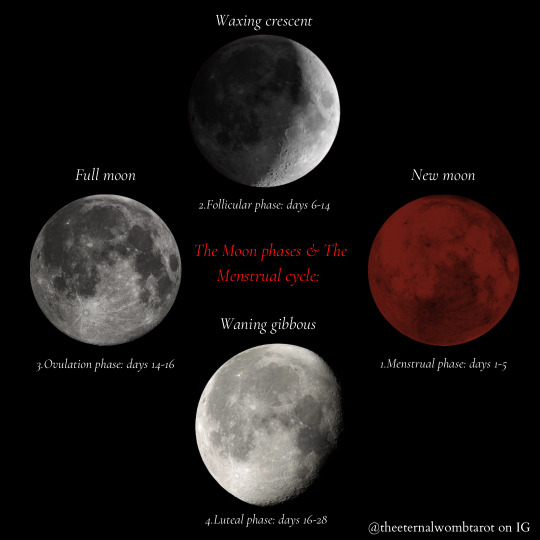
#divine feminine#divine masculine#relationships#love#menstrual cycle#spiritual enlightment#spirituality#cycle syncing#divine connections#divine counterpart
155 notes
·
View notes
Text
Different types of water & their magickal uses
Creeks & streams: Purification, harmony, cleansing
Dew: General health, eyesight, beauty. powertul if gathered at dawn on Beltane.
Ice: Transformations, balance, creativity
Lake water: Peace, contentment, relaxation, self-reflection.
River water: Cleansing, moving forward, protection
Snow: Transformations, balance
Spring water: Growth, holy water, cleansing, protection, prosperity
Swamp & waste water: Banishing, binding
Waterfalls: Power, energy, success
Well water: Healing, wishes, intuition
Beaches: Rituals, spells, fascinations, meditations
Rain water: Energy, protection, cleansing.
{The first rain of May is considered sacred}
#water magick#water magick uses#water witch#water witchcraft#witchblr#witchcore#witchcraft#witchlife#white witch#beginner witch#witch tips#green witch#grimoire#spirituality#book of shadows
2K notes
·
View notes
Text
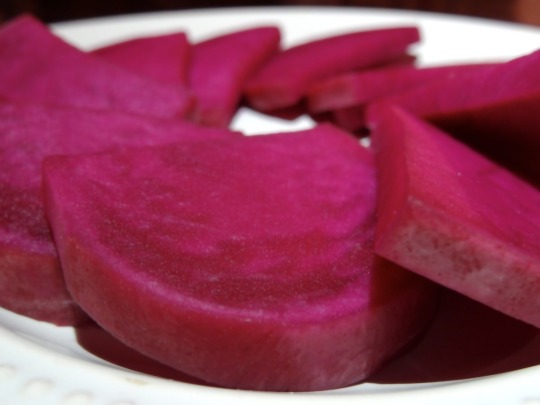
[ID: A circle of overlapping semi-circular bright pink pickles arranged on a plate, viewed from a low angle. End ID]
مخلل اللفت / Mukhallal al-lifit (Pickled turnips)
The word "مُخَلَّل" ("mukhallal") is derived from the verb "خَلَّلَ" ("khallala"), meaning "to preserve in vinegar." "Lifit" (with diacritics, Levantine pronunciation: "لِفِتْ"), "turnip," comes from the root "ل ف ت", which produces words relating to being crooked, turning aside, and twisting (such as "لَفَتَ" "lafata," "to twist, to wring"). This root was being used to produce a word meaning "turnip" ("لِفْتْ" "lift") by the 1000s AD, perhaps because turnips must be twisted or wrung out of the ground.
Pickling as a method of preserving produce so that it can be eaten out of season is of ancient origin. In the modern-day Levant, pickles (called "طَرَاشِيّ" "ṭarāshiyy"; singular "طُرْشِيّ" "ṭurshiyy") make up an important culinary category: peppers, carrot, olives, eggplant, cucumber, cabbage, cauliflower, and lemons are preserved with vinegar or brine for later consumption.
Pickled turnips are perhaps the most commonly consumed pickles in the Levant. They are traditionally prepared during the turnip harvest in the winter; in the early spring, once they have finished their slow fermentation, they may be added to appetizer spreads, served as a side with breakfast, lunch, or dinner, eaten on their own as a snack, or used to add pungency to salads, sandwiches, and wraps (such as shawarma or falafel). Tarashiyy are especially popular among Muslim Palestinians during the holy month of رَمَضَان (Ramaḍān), when they are considered a must-have on the إِفْطَار ("ʔifṭār"; fast-breaking meal) table. Pickle vendors and factories will often hire additional workers in the time leading up to Ramadan in order to keep up with increased demand.
In its simplest instantiation, mukhallal al-lifit combines turnips, beetroot (for color), water, salt, and time: a process of anaerobic lacto-fermentation produces a deep transformation in flavor and a sour, earthy, tender-crisp pickle. Some recipes instead pickle the turnips in vinegar, which produces a sharp, acidic taste. A pink dye (صِبْغَة مُخَلَّل زَهْرِي; "ṣibgha mukhallal zahri") may be added to improve the color. Palestinian recipes in particular sometimes call for garlic and green chili peppers. This recipe is for a "slow pickle" made with brine: thick slices of turnip are fermented at room temperature for about three weeks to produce a tangy, slightly bitter pickle with astringency and zest reminiscent of horseradish.
Turnips are a widely cultivated crop in Palestine, but, though they make a very popular pickle, they are seldom consumed fresh. One Palestinian dish, mostly prepared in Hebron, that does not call for their fermentation is مُحَشّي لِفِتْ ("muḥashshi lifit")—turnips that are cored, fried, and stuffed with a filling made from ground meat, rice, tomato, and sumac or tamarind. In Nablus, tahina and lemon juice may be added to the meat and rice. A similar dish exists in Jordan.
Turnips produced in the West Bank are typically planted in open fields (as opposed to in or under structures such as plastic tunnels) in November and harvested in February, making them a fall/winter crop. Because most of them are irrigated (rather than rain-fed), their yield is severely limited by the Israeli military's siphoning off of water from Palestine's natural aquifers to settlers and their farms.
Israeli military order 92, issued on August 15th, 1967 (just two months after the order by which Israel had claimed full military, legislative, executive, and judicial control of the West Bank on June 7th), placed all authority over water resources in the hands of an Israeli official. Military order 158, issued on November 19th of the same year, declared that no one could establish, own, or administer any water extraction or processing construction (such as wells, water purification plants, or rainwater collecting cisterns) without a new permit. Water infrastructure could be searched for, confiscated, or destroyed at will of the Israeli military. This order de facto forbid Palestinians from owning or constructing any new water infrastructure, since anyone could be denied a permit without reason; to date, no West Bank Palestinian has ever been granted a permit to construct a well to collect water from an aquifer.
Nearly 30 years later, the Interim Agreement on the West Bank and the Gaza Strip (also called the Oslo II Accord or the Taba Agreement), signed by Israel and the Palestine Liberation Organization (PLO) in 1995, officially granted Israel the full control over water resources in occupied Palestine that it had earlier claimed. The Argreement divided the West Bank into regions of three types—A, B, and C—with Israel given control of Area C, and the Palestinian Authority (PA) supposedly having full administrative power over Area A (about 3% of the West Bank at the time).
In fact, per article 40 of Annex 3, the PA was only allowed to administer water distribution in Area A, so long as their water usage did not exceed what had been allocated to them in the 1993 Oslo Accord, a mere 15% of the total water supply: they had no administrative control over water resources, all of which were owned and administered by Israel. This interim agreement was to be returned to in permanent status negotiations which never occurred.
The cumulative effect of these resolutions is that Palestinians have no independent access to water: they are forbidden to collect water from underground aquifers, the Jordan River, freshwater springs, or rainfall. They are, by law and by design, fully reliant on Israel's grid, which distributes water very unevenly; a 2023 report estimated that Israeli settlers (in "Israel" and in the occupied West Bank) used 3 times as much water as Palestinians. Oslo II estimations of Palestinians' water needs were set at a static number of million cubic meters (mcm), rather than an amount of water per person, and this number has been adhered to despite subsequent growth in the Palestinian population.
Palestinians who are connected to the Israeli grid may open their taps only to find them dry (for as long as a month at a time, in بَيْت لَحْم "bayt laḥm"; Bethlehem, and الخَلِيل "al-khalīl"; Hebron). Families rush to complete chores that require water the moment they discover the taps are running. Those in rural areas rely on cisterns and wells that they are forbidden to deepen; new wells and reservoirs that they build are demolished in the hundreds by the Israeli military. Water deficits must be made up by paying steep prices for additional tankards of water, both through clandestine networks and from Israel itself. As climate change makes summers hotter and longer, the crisis worsens.
By contrast, Israeli settlers use water at will. Israel, as the sole authority over water resources, has the power to transfer water between aquifers; in practice, it uses this authority to divert water from the Jordan River basin, subterranean aquifers, and بُحَيْرَة طَبَرِيَّا ("buḥayrat ṭabariyyā"; Lake Tiberias) into its national water carrier (built in 1964), and from there to other regions, including the Negev Desert (south of the West Bank) and settlements within the West Bank.
Whenever Israel annexes new land, settlers there are rapidly given access to water; the PA, however, is forbidden to transport water from one area of the West Bank to another. Israel's control over water resources is an important part of the settler colonial project, as access to water greatly influences the desirability of land and the expected profit to be gained through its agricultural exports.
The result of the diversion of water is to increase the salinity of the Eastern Aquifer (in the West Bank, on the east bank of the Jordan River) and the remainder of the Jordan that flows into the West Bank, reducing the water's suitability for drinking and irrigation; in addition, natural springs and wells in Palestine have run dry. In this environment, water for drinking and watering crops and livestock is given priority, and many Palestinians struggle to access enough water to shower or wash clothing regularly. In extreme circumstances, crops may be left for dead, as Palestinian farmers instead seek out jobs tending Israeli fields.
Some areas in Palestine are worse off in this regard than others. Though water can be produced more easily in the قَلْقِيلية (Qalqilya), طُولْكَرْم (Tulkarm) and أَرِيحَا ("ʔarīḥā"; Jericho) Districts than in others, the PA is not permitted to transfer water from these areas to areas where water is scarcer, such as the Bethlehem and Al-Khalil Districts. In Al-Khalil, where almost a third of Palestinian acreage devoted to turnips is located [1], and where farming families such as the Jabars cultivate them for market, water usage averaged just 51 liters per person per day in 2020—compare this to the West Bank Palestinian average of 82.4 liters, the WHO recommended daily minimum of 100 liters, and the Israeli average of 247 liters per person per day.
As Israeli settlement גִּבְעַת חַרְסִינָה (Givat Harsina) encroached on Al-Khalil in 2001, with a subdivision being built over the bulldozed Jabar orchard, the Jabars reported settlers breaking their windows, destroying their garden, throwing rocks, and holding rallies on the road leading to their house. In 2010, with the growth of the קִרְיַת־אַרְבַּע (Kiryat Arba) settlement (officially the parent settlement of Givat Harsina), the Jabars' entire irrigation system was repeatedly torn out, with the justification that they were stealing water from the Israeli water authority; the destruction continued into 2014. Efforts at connecting and expanding Israeli settlements in the Bethlehem area continue to this day.
Thus we can see that water deprivation is one tool among many used to drive Palestinians from their land; and that it is connected to a strategy of rendering agriculture impossible or unprofitable for them, forcing them into a state of dependence on the Israeli economy.
Turnips, as well as cabbage and chili peppers, are also grown in the village of وَادِي فُوقِين (Wadi Fuqin), west of Bethlehem. In 2014, Israel annexed about 1,250 acres of land in Wadi Fuqin, or a third of the village's land, "effectively [ruling] out development of the village and its use of this land for agriculture." Most of this land lies immediately to the west of a group of settlements Israel calls גּוּשׁ עֶצְיוֹן ("Gush Etzion"; Etzion Bloc). Building here would link several non-contiguous Israeli settlements with each other and with القدس (Al-Quds; "Jerusalem"), hemming Palestinians of the region in on all sides (many main roads through Israeli settlements cannot be used by anyone with a Palestinian ID). [2] PLO executive committee member Hanan Ashrawi said that the annexation, which was carried out "[u]nder the cover of [Israel's] latest campaign of aggression in Gaza," "represent[ed] Israel’s deliberate intent to wipe out any Palestinian presence on the land".
This, of course, was not the beginning of this strategy: untreated sewage from Gush Etzion settlements had been contaminating crops, springs, and groundwater in Wadi Fuqin since 2006, which also saw nearly 100 acres of Palestinian land annexed to allow for expansion of the Etzion Bloc.
All of this has obviously had an effect on Palestinian agriculture. A 1945–6 British survey of vegetable production in Palestine found that 992 dunums were devoted to Arab turnip production (954 irrigated and 38 rain-fed; no turnip production was attributed to Jewish settlers). A March 1948 UN report claimed that "[i]n most districts the markets are well-supplied with all the common winter vegetables—cabbages, cauliflowers, lettuce and spinach; carrots, turnips and and beets; beans and peas; green onions, eggplants, marrows and tomatoes." By 2009, however, the area given to turnips in Palestine had fallen to 918 dunums. Of these, 864 dunums were irrigated and 54 rain-fed. This represents an increase in unirrigated turnips (5.8%, up from 3.9%) that is perhaps related to difficulty in obtaining sufficient water.
Meanwhile, Israel profits from its restriction of Palestinian agriculture; it is the largest exporter of turnips in West Asia (I found no data for turnip exports from Palestine after 1922, suggesting that the produce is all for local consumption).
The pattern that Ashrawi called out in 2014 continued in 2023, as Israel's genocide in Gaza occurs alongside the continued and escalating killing and expulsion of West Bank Palestinians. The 2014 annexations, which represented the largest land grab for over 30 years and which appeared to institute a new era of state policy, have been followed up in subsequent years with more land claims and settlement-building.
Israeli military and settler raids and massacres in the West Bank, which had already killed 248 in 2023 before the حَمَاس (Hamas) October 7 offensive had taken place, accelerated after the attack, with forced expulsions of Palestinians (including Bedouin Arabs), and harassment, raids, kidnappings, and torture of Palestinians by a military armed with rifles, tanks, and drones. This violence has been opposed by armed resistance groups, who defend refugee camps from military raids with strategies including the use of improvised explosives.
Support Palestinian resistance by buying an e-sim for distribution in Gaza; donating to help two Gazans receive medical care; or donating to help a family leave Gaza.
[1] 918 dunums were devoted to turnips according to the Palestinian Central Bureau of Statistics (PCBS) report for 2009; the 2008 PCBS report attributes 253 dunums of turnip cultivation to Al-Khalil ("Hebron") for 2006–7.
[2] Today, Gush Etzion is connected to Al-Quds by an underground road that runs beneath the Palestinian Christian town of بَيتْ جَالَا (Bayt Jala).
Ingredients:
Makes 2 1-liter mason jars.
500g (4 medium) turnips
1 beetroot
1 medium green chili pepper (فلفل حار خضرة), halved
2 small cloves garlic, peeled
1 liter (4 cups) distilled or filtered water
25g coarse sea salt (or substitute an equivalent weight of any salt without iodine)
Some brining recipes for lifit call for the addition of a spoonful of sugar. This will increase the activity of lactic-acid-producing bacteria at the beginning of the fermentation, producing a quicker fermentation and a different, sourer flavor profile.
Instructions:
1. Clean two large mason jars thoroughly in hot water (there is no need to sterilize them).
2. Scrub vegetables thoroughly. Cut the top (root) and bottom off of each turnip. Cut each turnip in half (from root end to bottom), and then in 1 cm (1/2") slices (perpendicular to the last cut). Prepare the beetroot the same way.
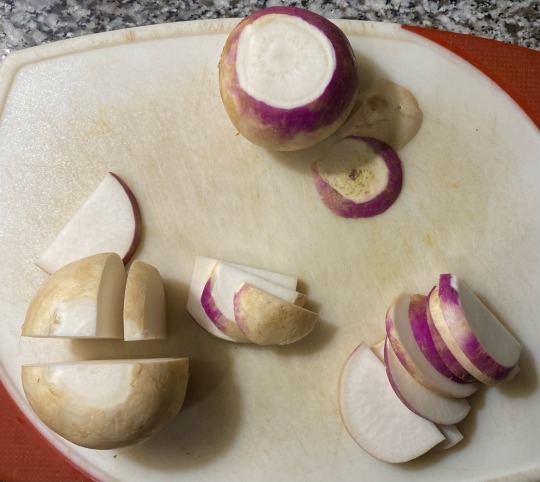
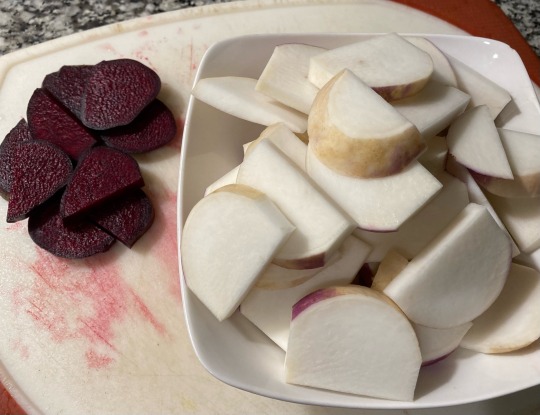
If you need your pickles to be finished sooner, cut the turnips into thinner slices, or into thick (1/2") baton shapes; these will need to be fermented for about a week.
3. Arrange turnip and beet slices so that they lie flat in your jars. Add garlic and peppers.
4. Whisk salt into water until dissolved and pour over the turnips until they are fully submerged. Seal with the jar's lid and leave in a cool place, or the refrigerator, for 20–24 days.

The amount of brine that you will need to cover the top of the vegetables will depend on the shape of your jar. If you add more water, make sure that you add more salt in the same ratio.

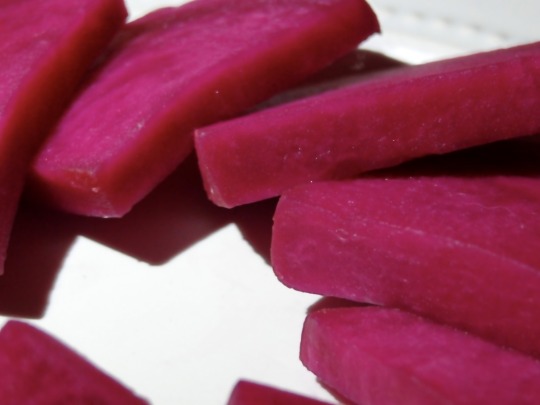
294 notes
·
View notes
Text




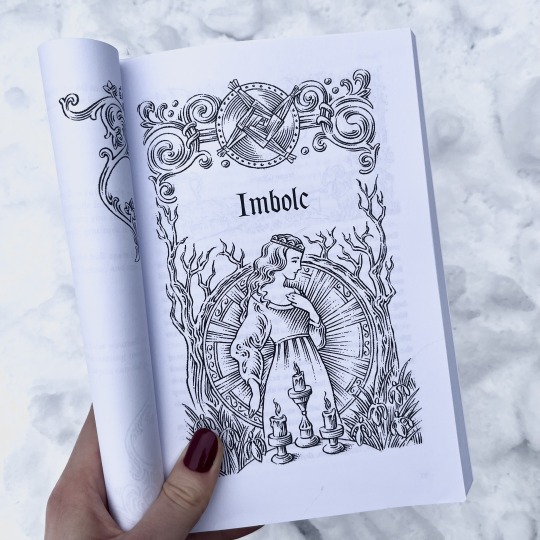
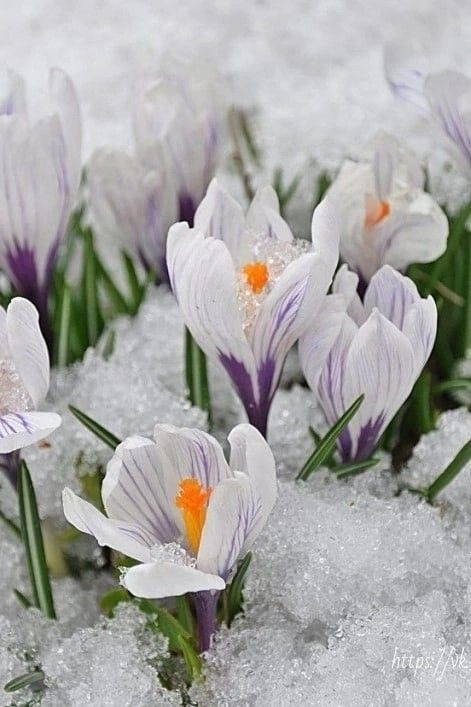
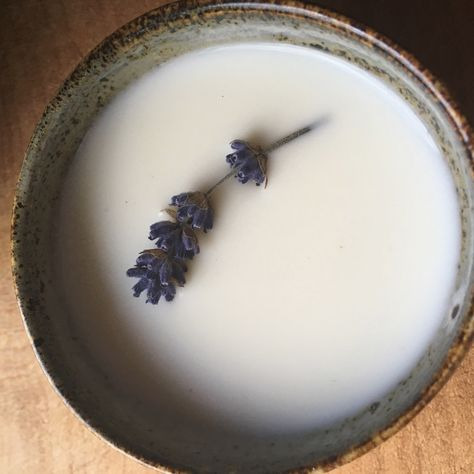


Imbolc "In the belly" (Feb 1-2) 🐑 Midway point between the winter solstice and spring equinox, Winter is slowly but surely coming to an end and spring is just around the corner. The days are getting longer and snowdrops, crocus and daffodils are starting to bloom. Farmers sow the first seeds, sheep are lactating and the first lambs are born. Imbolc is all about purification, fertility and rebirth.
Correspondences for Imbolc: Symbols; lambs, Brigid cross, candles, sun, fire, seeds, milk, spring flowers. Colors; white, pastels (green, yellow), earth tones, gold. Spells; Cleansing, gratitude, rebirth/renewal. Crystals; amethyst, quartz, aventurine, selenite, moonstone. Flowers and herbs; lavender, rosemary, cinnamon, bay leaf, chamomile. Food; pancakes, milk, soups, seasonal vegetables, seeds, cheese, yogurt, poppyseeds, homemade bread, cakes, dried fruits, teas. Imbolc activities; cleaning, planning your garden, planting the first seeds, nature walk, lightning candles, bake bread, make a Brigid cross, write poems, make art.
#whimsigothic#whimsigoth#whimsical#whimsigoth room#whimsigothcore#whimsigothaesthetic#witchy aesthetic#witches#witchy#witchyvibes#witch#witchcraft#witchythings#witchcore#witch aesthetic#witch blog#whimsical aesthetic#aesthetic#whimsigoth style#witchy vibes#winter solstice#wheel of the year#sabbats#imbolc#pagan#bridgid cross#maslenitsa#slavic
1K notes
·
View notes